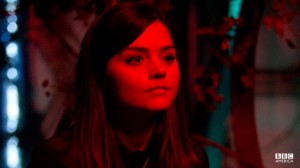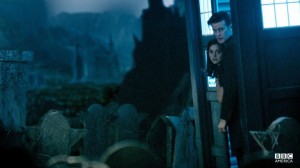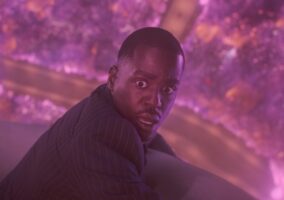We admit it; we’re impressed. Season seven may have been one of the least consistent, most frustrating seasons of Nu Who, but at least it ended really, really well; so well, in fact, that we’d call this one of the very best episodes of the relaunched series.
But let’s backtrack, because we stopped reviewing the show shortly after it came back from its hiatus and we  should probably explain why. Long story short: we weren’t happy. The first half of season 7 had its problems (not the least of which was the ill-thought-out manner of dispatching the Pond-Williamses), but the second half of the season went completely off the rails. There was far too much repetition, far too much bombast, and far too little explaining to the audience what the hell was going on. We were actually angry when we got to the end of the Neil Gaiman-scripted episode “Nightmare in Silver,” an episode that seemed to consist of nothing more than a lot of shouting. Sitting through it a second time, we realized there was a great story there and even some great scenes with crackling or poignant dialogue. The problem – and this has been a general problem for the last 6 episodes or so – was that a 90 minute or even two-hour story was being crammed into 60 minutes, including commercials. Which means exposition got glossed over or spoken so rapidly that no one could possibly make sense of it and entire bridge scenes were missing, leaving us with a very jerky story told in rapid, barking shouts.
should probably explain why. Long story short: we weren’t happy. The first half of season 7 had its problems (not the least of which was the ill-thought-out manner of dispatching the Pond-Williamses), but the second half of the season went completely off the rails. There was far too much repetition, far too much bombast, and far too little explaining to the audience what the hell was going on. We were actually angry when we got to the end of the Neil Gaiman-scripted episode “Nightmare in Silver,” an episode that seemed to consist of nothing more than a lot of shouting. Sitting through it a second time, we realized there was a great story there and even some great scenes with crackling or poignant dialogue. The problem – and this has been a general problem for the last 6 episodes or so – was that a 90 minute or even two-hour story was being crammed into 60 minutes, including commercials. Which means exposition got glossed over or spoken so rapidly that no one could possibly make sense of it and entire bridge scenes were missing, leaving us with a very jerky story told in rapid, barking shouts.
Even worse, we were presented with this “impossible girl,” storyline, which not only felt like warmed-over Amy Pond, it actually wound up being a much less impressively told tale in comparison to Amy’s. The “mystery” of Amy’s existence (as well as River’s) was a storyline that played out over many episodes, spanning multiple seasons. After the initial presentation of the “multiple Claras” conceit, we literally got no more information on the topic, in order to further the mystery and keep the audience involved. Instead, we got a lot of scenes of the Doctor, yelling, in effect, “WHO ARE YOU, YOU IMPOSSIBLE GIRL?!?!?” Rather than write the same whiny review pointing out the same issues every week, we opt ed to sit back and wait for an episode to wow us enough to jump back into the fray.
ed to sit back and wait for an episode to wow us enough to jump back into the fray.
This was the episode we were waiting for. In typing the following sentence, we’re just now realizing how difficult it must be to write a good Doctor Who story. This one worked because it had the best balance of adventure, pathos, humor, and darkness that defines the very best Who stories.
For the first time in a while, it really felt like the stakes were high. We’re used to Moffat setting up big stories that tend to fizzle out, but this one didn’t. From the very second the episode opened right up to that jaw-dropping (if you don’t scour the internet looking for Who news) final shot, the quality of the story remained very high.
In the end, it was all a fakeout on Moffat’s part. “Silence will fall when the Doctor is asked the one question that shouldn’t be asked, in the one place where no false word can be uttered.” That all turned out to be exactly true, although not in the way that anyone expected. It turns out the Silence actually had a good reason to stop the Doctor before he got to Trenzalore; because once he goes there, the prophecy is fulfilled and dozens of worlds and trillions of people will wink out of existence. In other words, the Silence wasn’t trying to kill the Doctor in order to stop him from doing good. The Silence was trying to kill him in order to preserve all the good he’d done. That’s quite a lovely twist, actually.
 But the biggest, best fakeout of all was saved for the very end. “The Name of the Doctor,” which has been a plot point ever since River whispered it into his ear so many years ago, is actually not the point. In fact, he comes right out and says so. The name of the Doctor was merely a key used to open a door to destruction, which is why it had any power at all. But the real meaning behind the phrase has to do not with the actual, true name of the character, but what is done in the character’s name.
But the biggest, best fakeout of all was saved for the very end. “The Name of the Doctor,” which has been a plot point ever since River whispered it into his ear so many years ago, is actually not the point. In fact, he comes right out and says so. The name of the Doctor was merely a key used to open a door to destruction, which is why it had any power at all. But the real meaning behind the phrase has to do not with the actual, true name of the character, but what is done in the character’s name.
“I did what I had to in the name of peace and sanity.”
“But not in THE NAME OF THE DOCTOR.”
Oh you clever boy, Steven Moffat. “The Name of the Doctor” doesn’t refer just to his actual name. It’s about the meaning and philosophy of the Doctor; the promise of the Doctor. Which is why our Doctor refers to the other one as, “the one who broke the promise.”
Having said all that, there were still some weak points to the story and they all refer back to the poor storytelling that’s been going on all season. The Great Intelligence’s spitting anger was never really explained or explored. He just hates the Doctor so much that he’s willing to destroy himself in order to destroy his nemesis. Well, fine. That’s classic villainy stuff. But without motivation (and we realize he’s an old character with roots going back to early Who) he becomes a cardboard cutout of villainy, just short of twirling a  mustache and tying a girl to train tracks. The same problem pops up when you consider Clara’s great sacrifice at the end. It was a wonderful moment, but it would have been even more wonderful if we had a better understanding of who the hell she is. Sure, we got her life story. Sort of. But all we really know about her is a couple bullet points and the fact that she can speak as quickly as the Doctor does. Aside from that, she’s generic “plucky English girl,” which is a Doctor Who character trope that could probably use a little rest.
mustache and tying a girl to train tracks. The same problem pops up when you consider Clara’s great sacrifice at the end. It was a wonderful moment, but it would have been even more wonderful if we had a better understanding of who the hell she is. Sure, we got her life story. Sort of. But all we really know about her is a couple bullet points and the fact that she can speak as quickly as the Doctor does. Aside from that, she’s generic “plucky English girl,” which is a Doctor Who character trope that could probably use a little rest.
Oh, and the Whisper Men were essentially The Silence (hissing men with unformed faces) in Victorian dress, which is yet another point in the column titled “Moffat is Running Out of Ideas.”
But really, we loved it. We’re pretty sure if a camera had been trained on us the whole hour, it would have caught a succession of facial expressions ranging from excitement to delight to sadness.
Okay, we’re getting long-winded here. Bullet time:
- Excellent use of Vastra, Strax and Jenny. Loved the time-traveling seance concept but found ourselves wishing Amy could’ve been one of the participants. “Not the one with the gigantic head” was a laugh-out-loud moment and not for the first time we find ourselves wishing that the show would ditch the “plucky English girl” companion model and just put these three on the TARDIS full-time for a season. Loved the creepiness of the seance being invaded. “I’m sorry, mum. So sorry. So sorry. I think I’ve been murdered.”
- It was wonderful to get an ending (although it’s one we’re not sure we buy) for River Song, even if it felt shoved into the story at the last second. The real shock with River was the reveal that we were dealing with the post-Library version of the character, something we’ve never seen except for in the epilogue of “Silence in the Library.” It was also nice to get a sense that the Doctor really did love her; something Moffat routinely failed to get across because (and this is another reason we took a break from recapping) he clearly has some women issues and can’t portray strong characters like Amy and River without making sure everyone hears the Doctor say how annoying he finds them – and women in general. Still, it was a truly fantastic goodbye to River; full of stubborness, wordiness, romance, anger, and frustration – all in a 3-minute scene. “Spoilers. Goodbye, Sweetie.” A beautiful payoff for the character; in some ways, a much better, more emotionally satisfying sendoff than Amy’s.
- “How did you do that?” “Disgracefully.”
- Matt Smith knocked it out of the park this week. His near-sobbing reaction to the word “Trenzalore” did more to ramp up the tension than five-hundred words of exposition dialogue.
- The “scar” wasn’t really explained very well.
- “How do we get there?” “We fall.” “The fall of the Eleventh” = turning off the antigrav. That one’s perhaps not so clever. Too cute by half.
- The Doctor’s immense sadness at seeing the TARDIS essentially in its death throes was heartbreaking.
- What exactly did Clara do to stop the Great Intelligence? What did the G.I. have to do with the Dalek Asylum, when we first met her?
- Why did River open the door, knowing that it would be catastrophic for the universe?
- We’ve always had one question in the back of our minds every time we see Madame Vastra in her Victorian finery with her Victorian sense of propriety; one question that Vastra answers just by existing: What if Mary Poppins was a lizard? Now do you see why we love her so?
- Clara’s timeline thing only gets confusing the more you think about it. She had different mothers and fathers each time? How does that work? And she’s on Gallifrey in one of her lives, which implies that at least one of them wasn’t human. But why do the versions of Clara we see throughout the timeline appear to be self-aware? The one on Gallifrey seemed to know the whole story of the Doctor. The other versions of Clara we met had no idea about the Doctor.
- The use of archival footage was great fun, but kind of distracting because the characters never seemed to occupy the same space. It’s not that hard to match eyelines, even if the reverse footage is shot 40 years later. And all the Great Intelligence seemed to do was stand and stare menacingly at the various versions of the Doctor.
- On the other hand, Clara’s ’70s and ’80s fashion was a treat for the eyes.
- “Introducing John Hurt as The Doctor.” That ranks right up there with “The Doctor will return in LET’S KILL HITLER” for great teases.
- Hurt is wearing what appears to by #8’s waistcoat and #9’s leather jacket. Hmmm.
Mad Style: Man With a Plan Next Post:
Mad T LOunge
Please review our Community Guidelines before posting a comment. Thank you!



